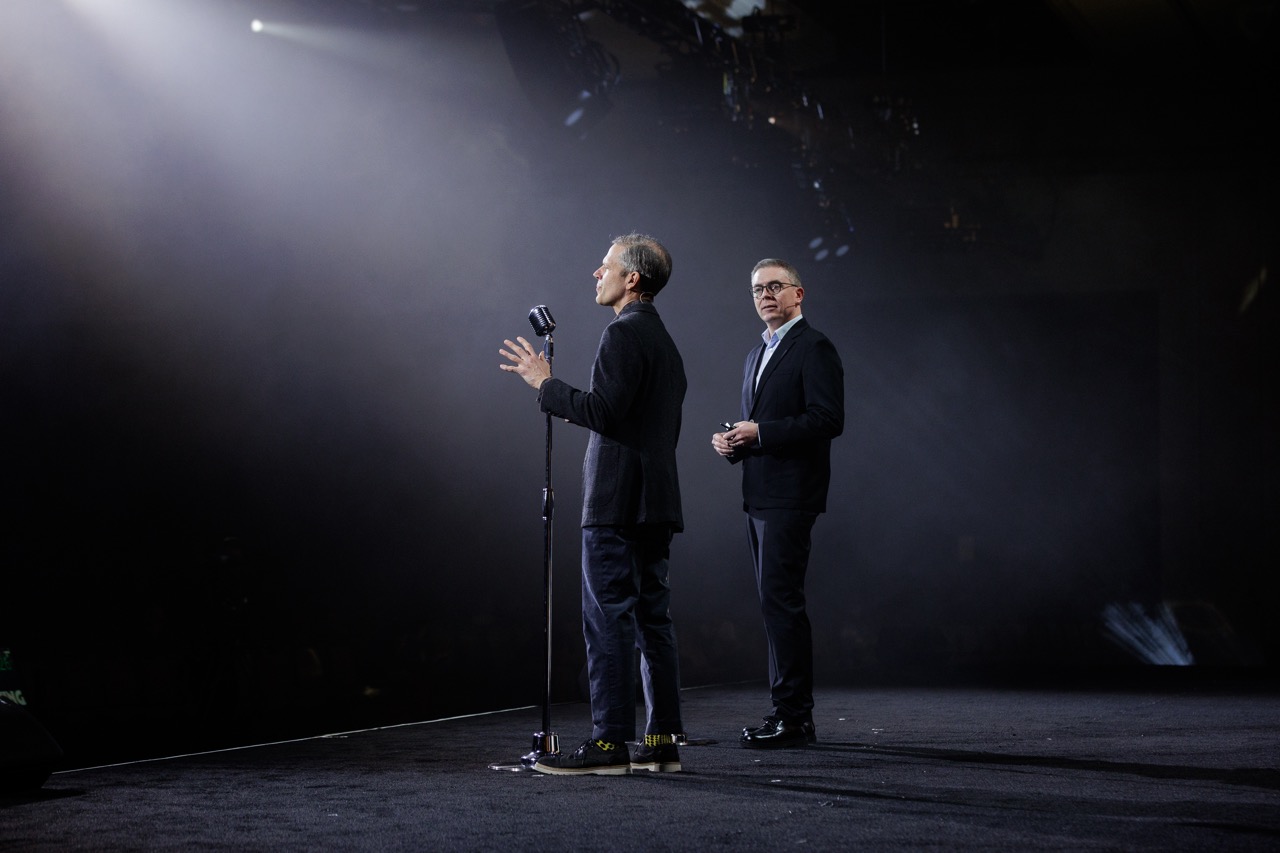The success of high-stakes corporate communication—from keynote speeches to complex internal training—hinges less on the volume of information delivered and more on its cognitive efficiency. The audience’s ability to process and retain data is constantly threatened by cognitive load, a bottleneck in working memory. In this context, acoustic architecture moves from an aesthetic consideration to a critical element of information science.
This article explores the neuroscientific basis for optimizing the soundscape in corporate environments to reduce cognitive load, enhance auditory comprehension, and strategically reinforce a speaker's authoritative presence.
The Auditory Cortex and Cognitive Filtering
The auditory system is highly susceptible to acoustic interference, which forces the brain to expend energy on filtering unwanted noise (reverberation, poor amplification, background hum) rather than processing the speaker's signal. This phenomenon directly increases cognitive load, diverting limited neural resources away from the executive functions required for analysis and retention.
For the C-suite, this translates directly to lost opportunity: diluted messages, misunderstood directives, and reduced compliance in training. A scientifically engineered soundscape proactively eliminates this interference.
- Precision Amplification: Achieving perfect gain staging and microphone placement ensures the speaker's fundamental frequency remains consistent and dominant, minimizing the need for the audience's auditory cortex to "fill in the gaps."
- Reverberation Control: In large event spaces, excessive reverberation blurs phonemes, degrading speech intelligibility. Advanced sound design and acoustic treatment are necessary to control the Reverberation Time (RT60), ensuring speech remains crisp and clear, thereby lowering the effort required for comprehension.

Engineering Authority: The Psychoacoustics of Executive Presence
Beyond simply hearing the words, the quality of sound influences the perceived authority and trustworthiness of the speaker—a key component of influence. Psychoacoustics, the study of the psychological response to sound, provides the blueprint.
Research demonstrates that certain acoustic characteristics convey dominance and confidence:
- Fundamental Frequency Stability: A consistent, stable vocal pitch—unmarred by feedback or clipping—is perceived as more credible.
- Spatial Consistency: Strategic use of surround or distributed audio arrays ensures the speaker's voice is localized and uniformly present, regardless of an audience member's seating position. This consistency reinforces the speaker's omnipresence and control.
- The Subliminal Sound Floor: Even the lack of sound is engineered. An exceptionally low noise floor (the residual background noise from equipment) eliminates subconscious distractions, allowing the audience to focus purely on the voice, reinforcing the message's importance.
From Scientific Design to Strategic Results
The strategic value of engineered acoustic architecture is measurable:
- Improved Information Transfer: Lowered cognitive load leads to higher scores in post-presentation knowledge retention assessments.
- Accelerated Alignment: Clear, authoritative sound reduces ambiguity and speeds up the time required for decision-making or organizational alignment on new strategies.
- Enhanced Brand Perception: Flawless audio delivery contributes significantly to the overall perception of professionalism and competence, validating the brand’s commitment to quality at the most fundamental level.
Achieving this scientific rigor in acoustic architecture requires a production partner with advanced knowledge of room tuning, signal processing, and psychoacoustic principles. It is the commitment to engineering every detail—even the invisible wave of sound—that turns corporate communication into optimal information transfer.

Beyond A/V: The Convergence of Data Science and Cinematic Production in Predictive Content Modeling
The era of intuitive, trial-and-error content creation is ending. For large enterprises operating in a data-rich environment, the next competitive frontier lies in fusing the rigorous methodology of data science with the emotive power of cinematic production. This convergence allows for the development of Predictive Content Models, enabling companies to anticipate audience response and maximize content efficacy before a single frame is finalized.
This article outlines the strategic process by which advanced data integration informs creative decision-making, transforming content production into a disciplined, outcome-guaranteed process.
The Limitation of Post-Mortem Analytics
Traditional content metrics—views, likes, shares—are purely historical, offering insights into past performance but failing to inform crucial in-flight or pre-production creative decisions. This reactive model leaves significant strategic value on the table.
Predictive Content Modeling (PCM) flips this paradigm. It utilizes existing organizational data—CRM journey mapping, sales funnel bottlenecks, previous campaign engagement metrics, and A/B test results—to establish quantifiable creative hypotheses before production begins.
The Role of Data Science in Pre-Production
The integration of data science begins at the concept phase, strategically guiding creative decisions:
- Narrative Structure Optimization: Data identifies which narrative arcs, lengths, and emotional beats were most effective in previous high-converting content. This allows the creative team to engineer a script structure that is statistically most likely to maintain engagement through critical points, avoiding audience drop-off.
- Colorimetry and Tone Mapping: Analytics on high-performing web pages or successful ad campaigns can isolate the color palettes, saturation levels, and lighting styles that elicited the strongest positive response from the target demographic. This data is then used to precision-map the color and lighting design of the new cinematic content.
- Pacing and Editing Hypothesis: Utilizing viewing time and drop-off data from past video assets, a predictive model can define the optimal average shot length and transition frequency required to maintain the audience's attention span, thereby dictating the editorial pace.
Implementing the Convergence Framework
This methodology requires a tight feedback loop and a production partner capable of handling the data complexity:
- KPI-Driven Creative Briefs: The brief must move beyond aesthetic goals (e.g., "make it look slick") to measurable outcomes (e.g., "increase engagement time by 15% at the 3:00 mark to secure click-through").
- Pre-Visualization with Data Weights: During pre-visualization (animatics or storyboards), data weights are applied to critical scenes. For example, if data suggests a specific product feature's visual explanation historically correlates with high conversion, that scene receives a higher production and editorial priority.
- Iterative Refinement: Initial test cuts of the content can be shown to micro-target groups, with eye-tracking or survey data providing quick feedback loops to refine pacing or visual density before full-scale production.
By treating cinematic production as a scientific hypothesis and leveraging organizational data as the primary creative input, large organizations move from hoping for impact to engineering it. This level of strategic foresight and technical integration is the hallmark of world-class audiovisual delivery.
The Flawless System: Applying Six Sigma Principles to Technical Production for Zero-Risk Live Events
For global organizations, a major live event—whether an investor presentation, a product launch, or a large internal summit—is a single point of failure with immense reputational and financial consequences. The mindset of "It might go wrong" is unacceptable. The imperative is to establish a technical framework that guarantees reliability, approaching the standard of Six Sigma (3.4 defects per million opportunities).
This article details how the rigorous, data-driven methodology of Six Sigma can be applied to audiovisual technical production, transforming event execution from a high-stress operation into a predictable, zero-risk system.
Transforming Production from Art to Process Control
Six Sigma is based on the principle of defining, measuring, analyzing, improving, and controlling processes to minimize variability and defects. In the context of audiovisual production, defects include any technical error: a dropped signal, an audio spike, a misfired graphic, or a power failure.
Applying this methodology requires a fundamental shift in how the production process is viewed:
- Define (D): Clearly define what constitutes a "defect" for the specific event. For a CEO keynote, a defect is not just a total failure but any latency or quality degradation noticeable by the C-suite or audience.
- Measure (M): Quantify the current technical failure rate (if possible) and establish the statistical capability of the system. This requires measuring system parameters (e.g., video signal integrity, power stability, network latency) under stress.
- Analyze (A): Use root cause analysis (RCA) on past minor incidents to isolate the variables responsible for potential failures (e.g., specific cable brands, signal conversion protocols, single points of power reliance).
Engineering Out Variability: The Redundancy Matrix
The "Improve" and "Control" phases of Six Sigma directly mandate the architecture of a zero-risk audiovisual system, primarily through standardized redundancy. This goes far beyond simply having a backup microphone.
- Input Redundancy: All critical signal paths (video, audio, data) must have automated, instantaneous fail-over mechanisms. This includes running parallel, diverse signal types (e.g., fiber and copper) to a single destination.
- Power Redundancy: All critical equipment must be on a triple-redundant power chain: Primary Utility > UPS (Uninterruptible Power Supply) > Generator/Secondary UPS. This is crucial for avoiding interruptions from common micro-failures like power dips.
- Operator Redundancy: Establishing clearly defined roles with a dedicated observer/controller (the "Green Belt" of the operation) whose sole function is to monitor system health and execute standardized emergency switch procedures.
- Standardized Equipment Protocol: Utilizing only certified, pre-tested, and standardized equipment across an entire event. This eliminates the "unknown variable" that mixing different manufacturers or cable types introduces, significantly reducing process variability.
The Strategic Value of Systemic Reliability
The investment in Six Sigma-level production is an investment in brand immutability. For global enterprises, guaranteeing technical perfection translates directly into strategic advantages:
- Risk Mitigation: Eliminates the probability of reputational damage stemming from visible public failures.
- Stakeholder Confidence: Projects an image of disciplined execution and operational excellence that resonates powerfully with investors and partners.
- Scalability: The standardized, documented process allows the organization to replicate this flawless execution across any location globally, ensuring consistent brand experience.
True professionalism is the guarantee of predictable high performance. By applying Six Sigma principles, audiovisual production transforms from a creative risk into a controlled, measurable, and guaranteed system of technical excellence.
The Physiology of Presence: Designing Human-Centric Stage Environments for Speaker Authority and Audience Focus
In high-level corporate communication, the stage environment is not merely a setting; it is a meticulously engineered psychological space designed to maximize the speaker's perceived authority and sustain the audience's cognitive focus. This discipline demands moving beyond aesthetics to apply principles of physiology, ergonomics, and visual psychology.
This article explores how a human-centric approach to stage design and technical execution enhances the speaker’s presence and minimizes the physiological triggers for audience fatigue and distraction.
The Psychology of Authority: Lighting and Framing
A speaker's perceived authority is heavily influenced by how their image is presented to the audience, both live and on screen.
- Key Lighting Design: Lighting must be engineered to provide facial modeling, creating depth and eliminating distracting shadows. Flat, generic lighting diminishes three-dimensionality, subtly reducing the perceived intellectual depth and dynamism of the speaker. Precision three-point lighting (key, fill, and back light) enhances the speaker's form, reinforcing their physical and conceptual presence.
- Visual Ergonomics (Framing): Camera operators are guided to use consistent framing that emphasizes the speaker's power center—the head and upper torso—while respecting the rule of thirds. This deliberate composition ensures the speaker remains the undeniable focal point, visually demanding attention and reinforcing their message's importance.
- Color Temperature: Strategic use of color temperature (often slightly warmer key lighting against a cooler background) creates contrast and separates the speaker from the stage environment, reducing visual fatigue and ensuring the speaker's image "pops."
Minimizing Cognitive Fatigue: The Audience’s Comfort
The success of long-duration events, such as full-day conferences or summits, hinges on preventing audience fatigue, which severely impacts information retention. Stage design must be physiologically considerate.
- Screen Brightness Calibration: LED wall and projection brightness must be carefully calibrated relative to the ambient lighting to avoid excessive contrast, a primary driver of eye strain and cognitive discomfort. The light emitted by the screen should integrate seamlessly into the overall environment.
- Flicker Control: High-quality refresh rates and technical specifications are non-negotiable. Sub-perceptible screen flicker can trigger unconscious visual stress, contributing to rapid audience fatigue.
- Stage-to-Audience Proximity: The physical distance and stage height must adhere to established visual sightline ergonomics, ensuring audience members are not forced into uncomfortable neck or viewing angles, which would break their concentration.
The Flawless Integration of Technology and Human Form
The final component of presence is the invisible integration of technology. The speaker must feel entirely unencumbered by the mechanics of the presentation.
- Invisible Prompting: Teleprompter placement must be positioned along the camera axis at the speaker's natural eye level, ensuring the audience perceives direct eye contact, which is a powerful psychological tool for building trust and reinforcing presence.
- Seamless Audio Integration: Minimizing visible technology (e.g., utilizing discreet body microphones) allows the audience to focus on the speaker's form and gesture rather than the equipment, removing cognitive barriers to connection.
Designing a human-centric stage environment is a testament to sophisticated engineering. By strategically managing the physiological and psychological variables of both the speaker and the audience, the production partner guarantees an environment where the content is maximized, the fatigue is minimized, and the speaker's authority is inherently amplified.




